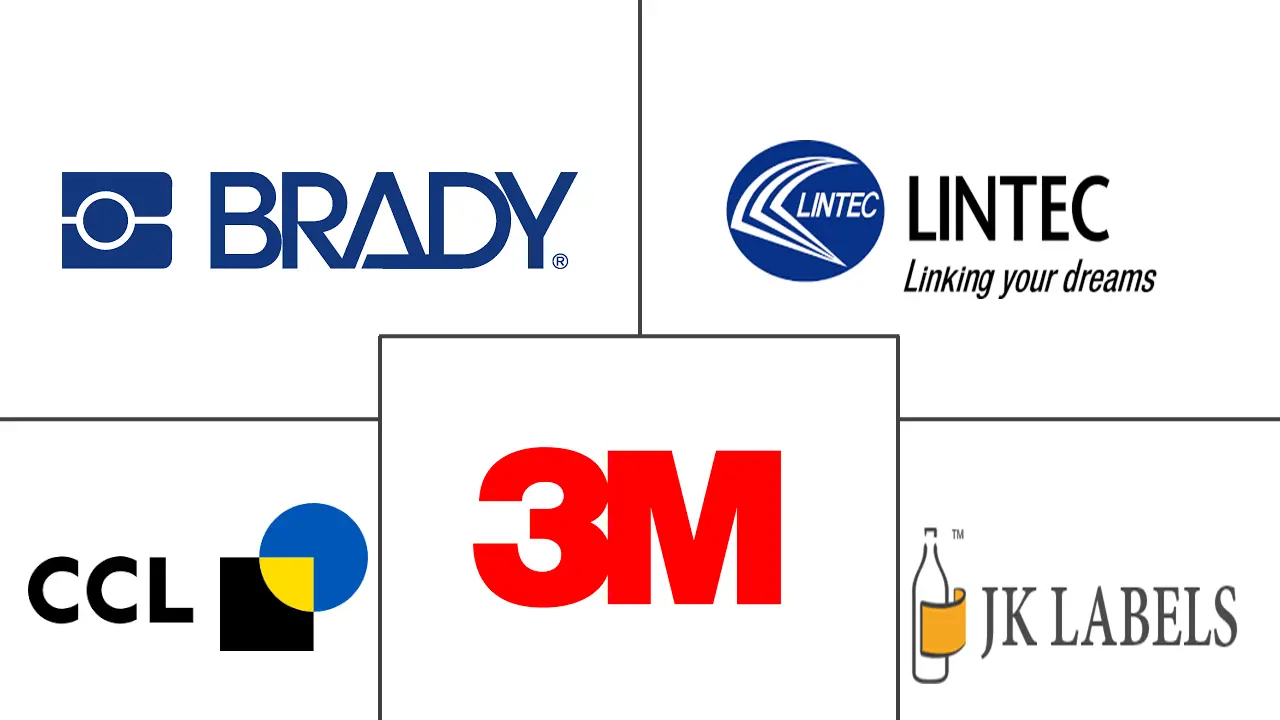Thermal Print Label Market Size and Share

Thermal Print Label Market Analysis by Mordor Intelligence
The thermal print label market reached 574.52 million m² in 2025 and is forecast to attain 687.64 million m² by 2030, reflecting a 3.66% CAGR throughout the period. This steady expansion signals a maturing yet resilient landscape in which rising e-commerce parcel flows, tightening healthcare serialization mandates, and a broad pivot toward automation keep demand moving on an upward path. Traditional paper substrates still dominate volumes, but rapid interest in synthetic, liner-less, and RFID-enabled options is reshaping product mix. Producers are battling raw-material inflation, import tariffs, and phenol-free reformulation costs even as they race to integrate sustainability credentials and smart features into next-generation labels. Strategic acquisitions accelerated through 2024–2025, giving larger converters end-to-end capabilities that address cost, compliance, and digital tracking requirements across global supply chains. Finally, the thermal print label market continues to benefit from technology’s inherent cost and speed edge over ink-based systems, balancing out headwinds from QR-code adoption and emerging digital alternatives.
Key Report Takeaways
- By material type, paper labels accounted for 60.13% of thermal print label market share in 2024; specialty synthetics are on track for a 6.35% CAGR to 2030.
- By label type, direct thermal technology held 60.23% of thermal print label market size in 2024, while thermal transfer is growing fastest at 4.86% CAGR.
- By end-use industry, food and beverages led with 40.53% 2024 revenue share; healthcare and pharmaceuticals are forecast to expand at 7.64% CAGR to 2030.
- By printing technology, industrial printers generated 45.64% of 2024 shipments; mobile printers are projected to rise at 6.73% CAGR through 2030.
- By region, North America captured 35.43% of 2024 demand, whereas Asia-Pacific is advancing at 7.32% CAGR on the back of e-commerce and manufacturing growth.
Global Thermal Print Label Market Trends and Insights
Drivers Impact Analysis
| Driver | (~) % Impact on CAGR Forecast | Geographic Relevance | Impact Timeline |
|---|---|---|---|
| Healthcare & pharma thermal label demand | +1.2% | North America & EU | Medium term (2-4 years) |
| E-commerce shipping label surge | +1.8% | North America & Asia-Pacific | Short term (≤ 2 years) |
| Cost & speed edge over ink-based printing | +0.7% | Global | Long term (≥ 4 years) |
| RFID-enabled smart labels | +0.9% | North America & EU, expanding in Asia-Pacific | Long term (≥ 4 years) |
| Liner-less label adoption | +0.6% | EU & North America | Medium term (2-4 years) |
| Antimicrobial coated materials | +0.4% | Developed markets | Medium term (2-4 years) |
| Source: Mordor Intelligence | |||
Rise in Demand for Thermal Labels in Healthcare and Pharmaceuticals
Global serialization deadlines in November 2024 triggered high-volume deployments of thermal print systems throughout pharma packaging lines. Drug makers centralized thousands of label files into standardized workflows that cut user error and kept pace with DSCSA lot-level tracing expectations. Blood bags, syringes, and cold-chain vials now use durable direct thermal tags that withstand refrigerated storage while preserving barcode readability for decades. Clinical-trial operators are piloting digital display labels that can update dosing data on demand without manual relabeling, raising throughput and patient safety simultaneously.[1]ISPE, “Digital Display Labeling in Clinical Supplies,” ispe.orgThe result is a stable revenue stream insulated from broader economic cycles, reinforcing the thermal print label market as an essential backbone of regulated healthcare distribution.
Surge in E-commerce Shipping and Logistics Label Volumes
Amazon Logistics processed 5.9 billion parcels in 2024, a 15.7% year-on-year jump that directly injected fresh label demand into fulfillment centers. Pitney Bowes projects 29 billion parcels in the United States by 2029, locking in multi-year thermal label purchase agreements across parcel carriers, 3PLs, and in-house shipper hubs. Warehouses are deploying automated print-and-apply robots to remove human error and achieve near-zero downtime, as shown by beverage and grocery installations completed in 2024. Same-day delivery models require extra touchpoint labels to enable real-time routing, making thermal printers an operational necessity. Prologis notes falling vacancy across last-mile facilities and predicts sustained air-cargo growth, both of which expand the installed base of high-speed label applicators.
Cost and Speed Advantages Versus Ink-based Printing
Thermal printers operate without ink or toner, trimming lifetime consumable expenses by up to 40% and powering throughput that reaches 12 ips in demanding sortation tunnels. Fewer moving parts translate into reduced maintenance schedules and extended service intervals, cutting downtime for round-the-clock facilities. Thermal units also consume about 60% less electricity than UV-curable ink platforms, an attractive metric as energy prices rise. Archival tests show direct thermal images can last 30 years in ambient warehouses, comfortably meeting most regulatory retention windows. These economics anchor the thermal print label market against competing print modalities even in price-sensitive environments.
Emergence of RFID-enabled Printable Smart Labels
Integrating RFID chips with classical thermal output delivers item-level visibility that barcode-only systems cannot replicate. Multi-Color Corporation’s purchase of Starport Technologies in late 2024 gave it embedded inlay capabilities that serve pharmaceuticals and premium CPG lines. Retailers are now adopting frictionless checkout models where RFID-encoded labels automate basket tallies, boosting demand for printers that can encode and print in one pass. Zebra Technologies partnered with Merck KGaA on the M-Trust authentication platform in 2025 to fight counterfeiting through secure thermal-printed tags. Growing IoT deployments in cold-chain monitoring further widen the application base for smart thermal labels that transmit temperature or shock events.
Restraints Impact Analysis
| Restraint | (–) % Impact on CAGR Forecast | Geographic Relevance | Impact Timeline |
|---|---|---|---|
| BPA regulations & thermal paper cost swings | -0.8% | EU & California | Short term (≤ 2 years) |
| Durability limits of direct-thermal in harsh settings | -0.5% | Global industrial sites | Medium term (2-4 years) |
| QR-code shift reducing label volumes | -1.1% | Global retail | Medium term (2-4 years) |
| Printhead supply constrained by chip shortages | -0.3% | Asia-Pacific | Short term (≤ 2 years) |
| Source: Mordor Intelligence | |||
BPA Regulations and Thermal Paper Supply Volatility
California added bisphenol S to Proposition 65 in December 2023, forcing distributors to relabel or reformulate stock by end-2024, a move that mirrored the EU’s earlier BPA ban. Studies in 2025 still detect high BPS loads in many thermal grades, spurring calls for a broader phenol crackdown that could drive another round of R&D and price hikes. Several mills announced 10% price rises in 2025 citing tariff burdens and chemistry conversion costs, squeezing converters’ margins. The uncertainty pushes end users toward synthetic ribbons or direct thermal phenol-free substrates that typically cost more per impression.
Shift to Digital QR Codes Reducing Label Volumes
GS1’s initiative to replace one-dimensional barcodes with 2D QR formats by 2027 has backing from 22 multinationals and pilots across 48 countries. Retail executives overwhelmingly expect full switchover by 2030 as QR codes embed dynamic data layers and consumer engagement tools. Australian grocer Woolworths already scans more than 9 million QR codes each week, cutting food waste by 40% through better expiry tracking. While thermal printers still produce the initial QR label, the shift tends to consolidate multiple SKU or promo labels into one, placing downward pressure on volume growth within the thermal print label market.
Segment Analysis
By Material Type: Paper Strength Meets Synthetic Innovation
Paper labels commanded 60.13% of thermal print label market share in 2024, reflecting low cost, universal printer compatibility, and established supply networks. The segment supplies high-volume applications such as shipping, receipts, and grocery price tags, where life-span demands rarely exceed a few days. Specialty synthetics delivering chemical, moisture, and UV resistance are now pacing at 6.35% CAGR to 2030 as automotive, electronics, and petrochemical customers demand longer-life identifiers. UPM Raflatac’s Carbon Action Label portfolio illustrates how bio-based films narrow the sustainability gap with paper while retaining performance. Over the forecast horizon, incremental migration toward higher-margin synthetics helps lift average selling prices inside the thermal print label market.
Market entrants that specialize in tamper-evident foils and holographic laminates find opportunities in pharmaceuticals and luxury goods, niches less sensitive to raw material inflation. Security substrates guard against counterfeit diversion by integrating color-shifting pigments readable under UV inspection. Meanwhile, liner-less paper grades begin eating into traditional coated offerings as converters adapt pressing equipment for support-free webs. Together these trends nudge the material landscape toward a balanced mix where cost, durability, and sustainability dictate substrate selection.
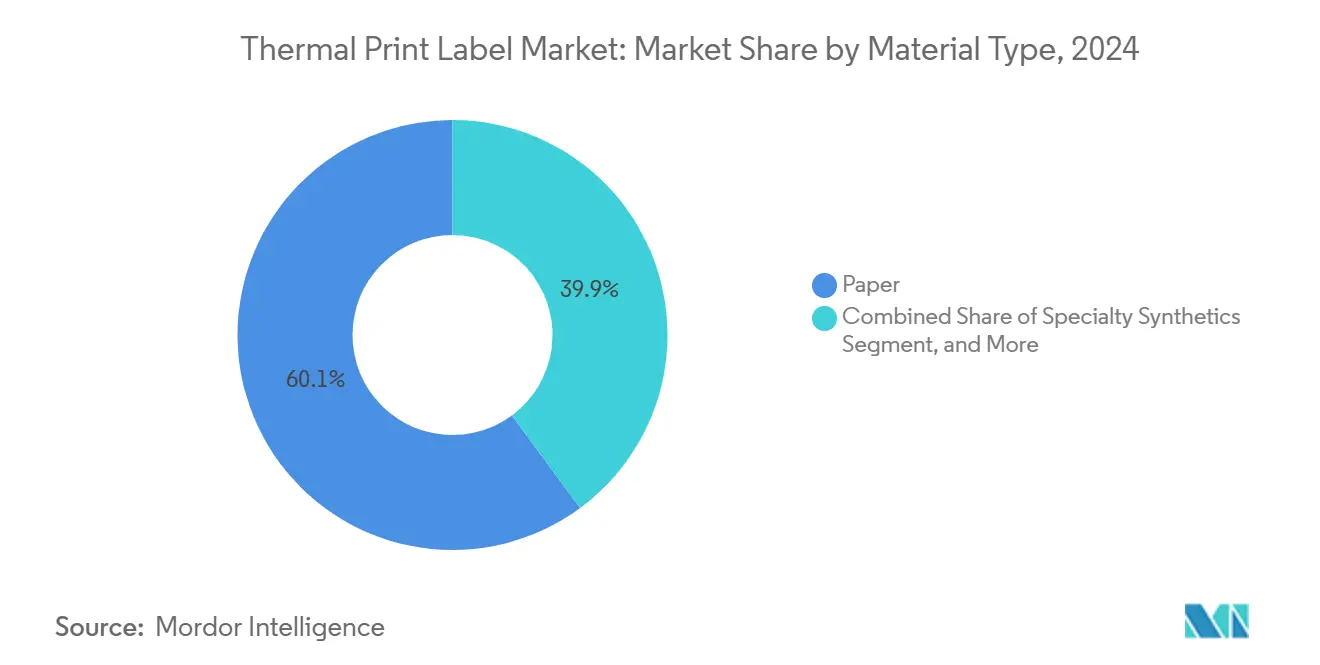
Note: Segment shares of all individual segments available upon report purchase
By Label Type: Direct Thermal Leadership Faces Transfer Upside
Direct thermal facestocks delivered 60.23% of thermal print label market size in 2024 owing to straightforward printer mechanics and ribbon-free operation that suits pick-pack-ship lines. However, print darkening from heat or scuffing limits their use in industrial and outdoor settings. Thermal transfer labels, combining resin or wax ribbons with paper or film, are accelerating at 4.86% CAGR. Manufacturers such as Domino rolled out high-speed thermal transfer overprinters that handle 1,200 mm ribbon rolls, slashing changeovers and downtime.[2]Domino Printing Sciences, “High-Speed Thermal Transfer Overprinter,” domino-printing.comResin formulas increasingly meet UL and CSA durability ratings, widening the addressable market in electronics, automotive, and chemical drums. As retailers adopt 2D codes rich in expiration and batch data, hybrid direct-thermal topcoats engineered for better scratch resistance could temper migration but will not fully stem the expansion of transfer-based systems.
In niche coding of flexible films, overprinting onto pouches and flow wraps has become mainstream as single-serve portions proliferate. Thermal transfer thereby positions itself as the premium durability solution within the broader thermal print label market, particularly where print contrast and chemical stability carry regulatory weight.
By End-use Industry: Food Dominance Confronts Healthcare Momentum
Food and beverages absorbed 40.53% of 2024 shipments owing to stringent traceability rules, private-label SKU growth, and high-turnover supermarket supply chains. Brewer Duvel Moortgat’s full factory traceability example demonstrates the multimodal labeling layers required from brew-kettle to pallet. Looking ahead, sustainability pledges push grocers to liner-less or phenol-free stocks, offering growth headroom inside a still-dominant vertical. The healthcare and pharmaceutical channel records a 7.64% CAGR through 2030 as serialization and cold-chain management stay top of mind. Thermal labels withstand cryogenic storage on biologics and vaccines, guaranteeing scan reliability at hand-off checkpoints.
Logistics, the third-ranked adopter, scales with parcel-volume curves tied to omnichannel retail and international trade flows. Retail itself is pivoting to RFID tagging for inventory views, with Avery Dennison noting mid-single-digit growth in its Intelligent Labels unit on apparel and food applications. Additional runway appears in manufacturing plants implementing Industry 4.0, where asset monitoring and WIP tracking drive printer installs on every line.
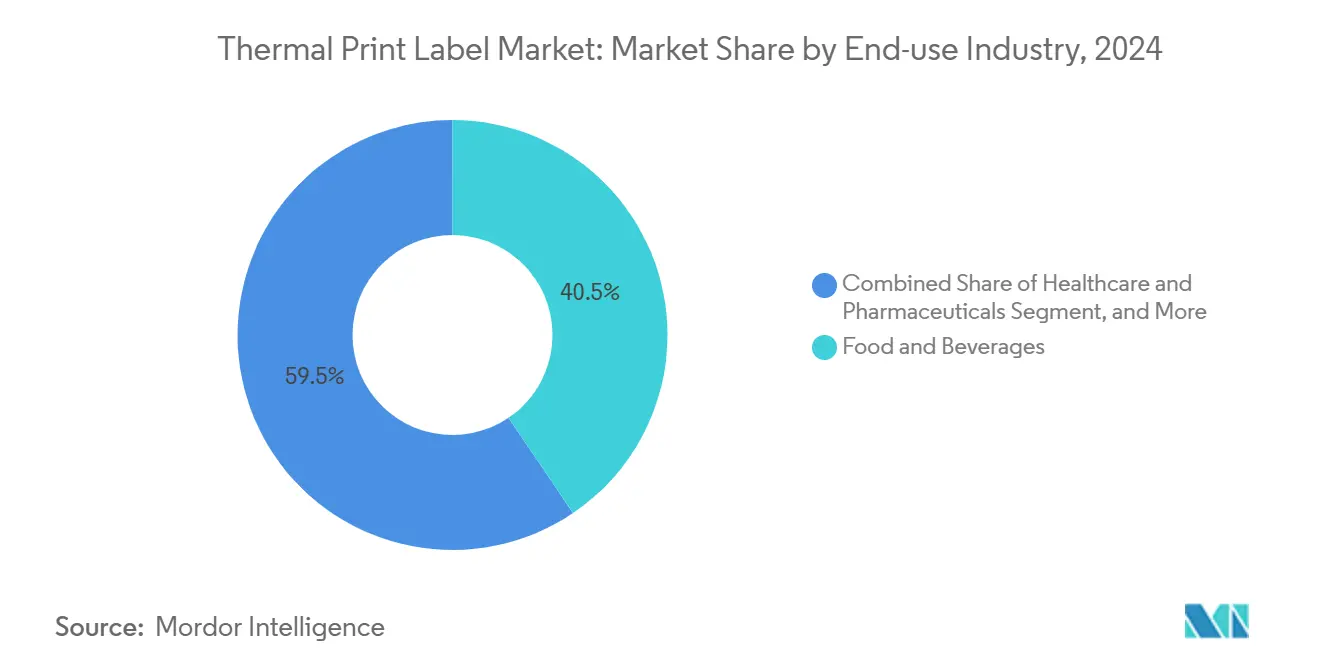
Note: Segment shares of all individual segments available upon report purchase
By Printing Technology: Industrial Workhorses Outpaced by Mobile Growth
Industrial tabletop and in-line units generated 45.64% of 2024 printer sales, anchoring high-speed warehouses and factory cells. These systems integrate SAP or Oracle MES data streams, feeding applicators that run 24/7 with minimal intervention. Investment cycles continue as parcel carriers automate small sort centers and as new fulfillment facilities open in secondary metros. Mobile printers, however, post the fastest 6.73% CAGR to 2030 as field technicians, home-health nurses, and curbside pickup attendants demand on-the-spot label generation tied to handheld devices. Advances in Li-ion battery density and wireless protocols shrink weight and broaden duty cycles, lowering the adoption barrier further.
Desktop printers bridge the gap for SMB offices where label demand sits between 5,000 and 25,000 imprints monthly. Printhead manufacturing constraints related to semiconductor allocations eased somewhat in 2025 as Epson completed its Akita line, tripling future output capacity and alleviating backlog across all printer classes.
Geography Analysis
North America retained 35.43% of global demand in 2024 as entrenched e-commerce habits, labor cost pressures, and regulatory compliance needs stimulated ongoing thermal label investment. Amazon’s parcel volumes, combined with stringent DSCSA enforcement, anchored order pipelines for media and printer OEMs. Canada and Mexico also signal steady allocations for cross-border shipping and automotive traceability mandates.
Europe sits in second position, shaped by the EU’s phenol bans, incoming Digital Product Passport rules, and carbon-reduction targets. Converters fast-track liner-less lines to meet retailer packaging scorecards, while German machine builders export automated applicators across the region. The European Food Safety Authority’s scrutiny over chemical migration adds urgency for phenol-free paper and film adoption, creating a premium niche within the thermal print label market.
Asia-Pacific leads growth at 7.32% CAGR as China’s domestic e-commerce giants expand rural logistics networks and India digitizes its pharmaceutical supply chain. Local printhead production ramps in Japan and China, trimming lead times for regional OEMs. Southeast Asian exporters adopt English-language nutrition and country-of-origin labels to access Western markets, contributing incremental demand. South America and the Middle East trail in volume but invest in customs compliance and oil-field service labeling, often sourcing printers from multinational vendors assembled within the region.
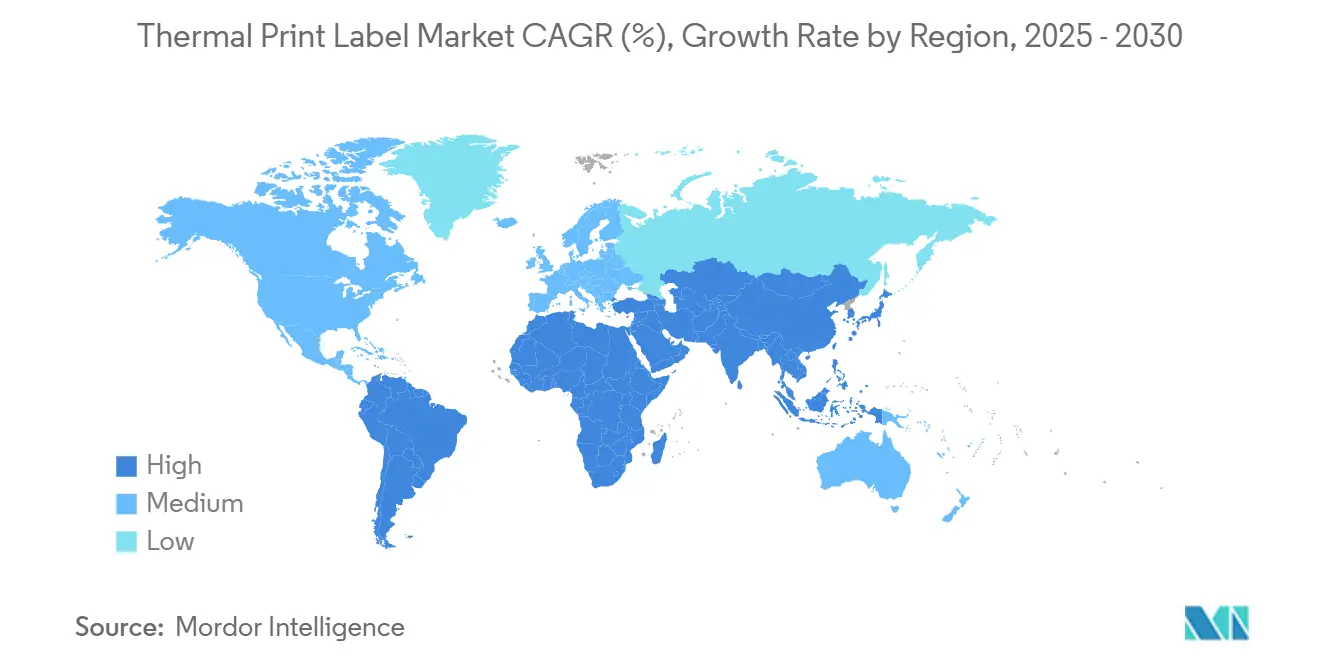
Competitive Landscape
The marketplace features a blend of diversified material science giants and regional converters, resulting in moderate fragmentation. OMNI Systems’ 2024 purchase of Honeywell Media broadened its thermal media reach, while ProMach’s acquisition of Panther Industries the same year bolstered print-and-apply automation portfolios.[3]OMNI Systems, “OMNI Systems Completes Acquisition of Honeywell Media,” omnisystem.com Multi-Color Corporation’s smart-label acquisition spree provides deeper RFID capabilities, illustrating how inorganic growth secures proprietary technology ahead of scaled competitors.
Technology rivalry centers on substrate R&D and encoding intelligence rather than bare print speed. Zebra Technologies’ M-Trust collaboration epitomizes co-development aimed at anti-counterfeiting and authentication extensions beyond shipping labels. Meanwhile, 3M channels adhesives know-how into low-energy liner-less constructions that run on legacy hardware with minimal change parts. Patent filings tracked by DayMark Safety Systems show continued innovation in date-coding formats aimed at foodservice safety.
Financial performance underscores resilience: CCL Industries logged record 8.6% sales expansion in Q1 2025 on top of nine acquisitions since 2023, while Zebra posted an 11.3% revenue lift and EBITDA margin of 22.3% in the same quarter. The quest for end-to-end solutions integrating media, hardware, and software drives further consolidation, though regional specialists remain competitive through speed of service and intimate customer knowledge.
Thermal Print Label Industry Leaders
-
CCL Industries Inc.
-
3M Company
-
Lintec Corporation
-
Brady Corporation
-
JK Fine Prints Pvt. Ltd. (JK Labels Pvt. Ltd.)
- *Disclaimer: Major Players sorted in no particular order
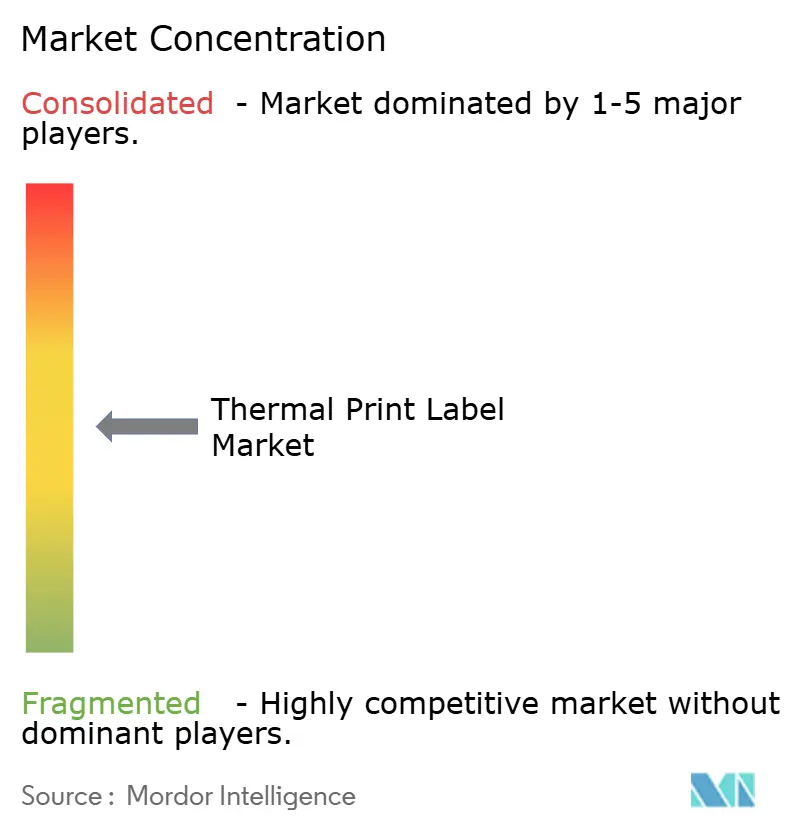
Recent Industry Developments
- May 2025: CCL Industries reported record Q1 2025 revenue of CAD 1.8 billion, up 8.6%, supported by recent specialty label acquisitions.
- April 2025: Zebra Technologies posted Q1 2025 net sales of USD 1.308 billion, with adjusted EBITDA margin expanding to 22.3%.
- April 2025: Avery Dennison recorded USD 2.1 billion Q1 2025 revenues; Intelligent Labels delivered mid-single-digit growth.
- March 2025: ProMach’s ID Technology division acquired Etiflex, expanding RFID label capacity in Mexico.
Global Thermal Print Label Market Report Scope
The thermal print label market encompasses the manufacturing and distribution of labels produced through thermal printing technology. The process involves applying heat to transfer ink or activating color-changing chemicals on label materials. These labels serve various industries, including retail, logistics, healthcare, and manufacturing. Their primary applications include barcoding, product identification, and shipping, where rapid, precise, and durable labeling is essential.
The thermal print label market is segmented by material type (paper, synthetics (polyesters, polypropylene), special synthetics (laminates, aluminum foils, etc.)), label type (direct thermal labels, thermal transfer labels), end-user industry (food and beverages, healthcare and pharmaceuticals, logistics and transportation, retail, e-commerce, manufacturing and electronics, other end-user industries (personal care and cosmetics, chemicals, etc.)), geography (North America [United States, Canada], Europe [Germany, United Kingdom, France, Spain, Italy, and Rest of Europe], Asia-Pacific [India, China, Japan, and Rest of Asia-Pacific], Latin America [Brazil, Mexico, and Rest of Latin America], Middle East and Africa [United Arab Emirate, Saudi Arabia, South Africa, Rest of Middle East and Africa]). The market size and forecasts are provided in terms of volume (square meters) for all the above segments.
| Paper |
| Synthetics (PP, PET) |
| Specialty Synthetics (laminates, foils, BOPP, etc.) |
| Other Material Type |
| Direct Thermal Labels |
| Thermal Transfer Labels |
| Food and Beverages |
| Healthcare and Pharmaceuticals |
| Logistics and Transportation |
| Retail |
| E-commerce Fulfilment Centres |
| Manufacturing and Electronics |
| Other End-use Industry |
| Desktop Printers |
| Industrial Printers |
| Mobile Printers |
| In-line/TTO (Thermal Transfer Over-printing) |
| North America | United States | |
| Canada | ||
| Mexico | ||
| Europe | Germany | |
| United Kingdom | ||
| France | ||
| Italy | ||
| Spain | ||
| Russia | ||
| Rest of Europe | ||
| Asia-Pacific | China | |
| India | ||
| Japan | ||
| South Korea | ||
| Australia and New Zealand | ||
| Rest of Asia-Pacific | ||
| Middle East and Africa | Middle East | United Arab Emirates |
| Saudi Arabia | ||
| Turkey | ||
| Rest of Middle East | ||
| Africa | South Africa | |
| Nigeria | ||
| Egypt | ||
| Rest of Africa | ||
| South America | Brazil | |
| Argentina | ||
| Rest of South America | ||
| By Material Type | Paper | ||
| Synthetics (PP, PET) | |||
| Specialty Synthetics (laminates, foils, BOPP, etc.) | |||
| Other Material Type | |||
| By Label Type | Direct Thermal Labels | ||
| Thermal Transfer Labels | |||
| By End-use Industry | Food and Beverages | ||
| Healthcare and Pharmaceuticals | |||
| Logistics and Transportation | |||
| Retail | |||
| E-commerce Fulfilment Centres | |||
| Manufacturing and Electronics | |||
| Other End-use Industry | |||
| By Printing Technology | Desktop Printers | ||
| Industrial Printers | |||
| Mobile Printers | |||
| In-line/TTO (Thermal Transfer Over-printing) | |||
| By Geography | North America | United States | |
| Canada | |||
| Mexico | |||
| Europe | Germany | ||
| United Kingdom | |||
| France | |||
| Italy | |||
| Spain | |||
| Russia | |||
| Rest of Europe | |||
| Asia-Pacific | China | ||
| India | |||
| Japan | |||
| South Korea | |||
| Australia and New Zealand | |||
| Rest of Asia-Pacific | |||
| Middle East and Africa | Middle East | United Arab Emirates | |
| Saudi Arabia | |||
| Turkey | |||
| Rest of Middle East | |||
| Africa | South Africa | ||
| Nigeria | |||
| Egypt | |||
| Rest of Africa | |||
| South America | Brazil | ||
| Argentina | |||
| Rest of South America | |||
Key Questions Answered in the Report
What is the current size of the thermal print label market and how fast is it growing?
The thermal print label market stood at 574.52 million m² in 2025 and is forecast to reach 687.64 million m² by 2030, posting a 3.66% CAGR.
Which factors are driving demand for thermal print labels through 2030?
E-commerce parcel growth, healthcare serialization mandates, and the cost-speed edge of thermal printing over ink-based systems are the primary demand catalysts.
Which material segment is expanding the fastest?
Specialty synthetic labels, valued for durability and chemical resistance, are rising at a 6.35% CAGR, outpacing traditional paper stocks.
How are QR codes expected to influence future label volumes?
The retail shift to data-rich QR codes may consolidate multiple stickers into one, applying downward pressure on total label volumes even though thermal printing remains the initial application method.
Which region offers the highest growth rate for vendors?
Asia-Pacific leads with a projected 7.32% CAGR, fueled by manufacturing expansion and rapid adoption of online retail logistics.
Is the competitive landscape consolidated or fragmented?
The sector remains moderately fragmented; recent acquisitions by large converters are lifting the top five players’ combined share to around 60–65%, indicating a mid-level market concentration.
Page last updated on:
